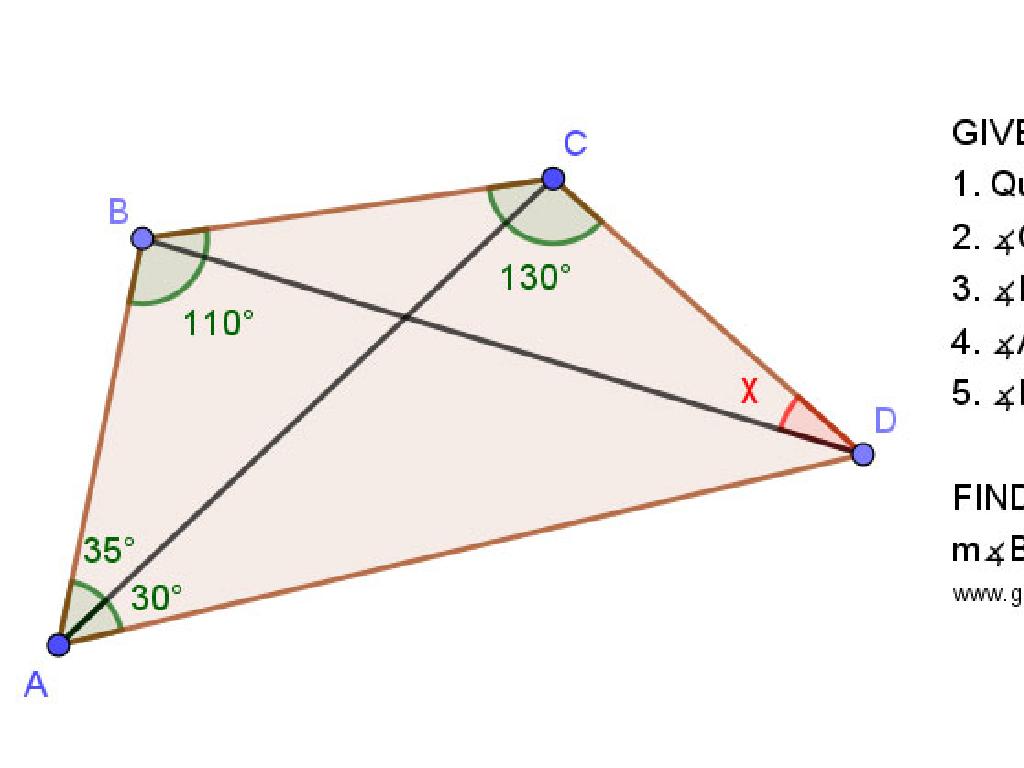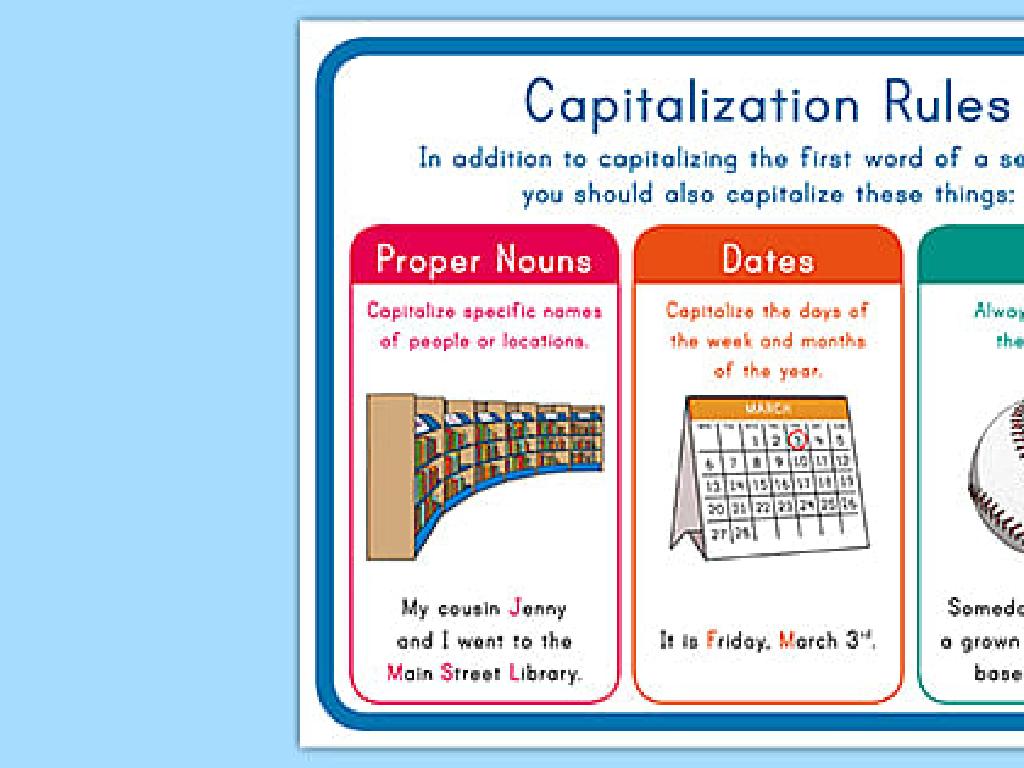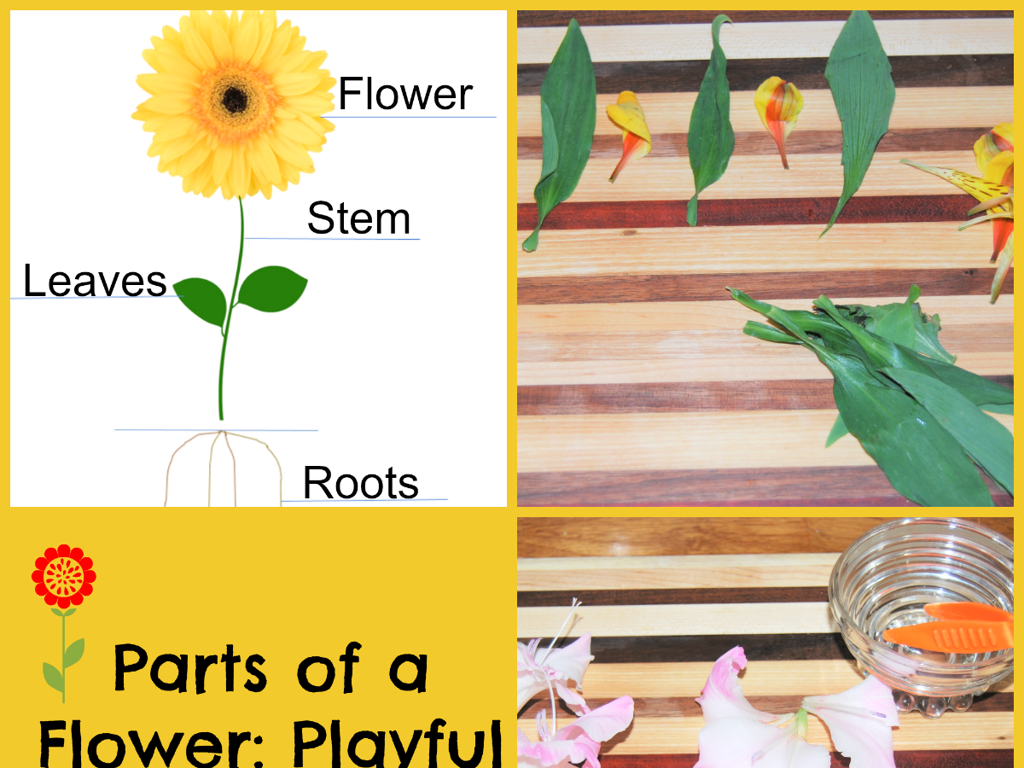Divide By 5
Subject: Math
Grade: Third grade
Topic: Division Skill Builders
Please LOG IN to download the presentation. Access is available to registered users only.
View More Content
Today’s Adventure: Divide by 5!
– What is division?
– Division means sharing equally
– If we have 10 apples and 5 friends, how many apples does each friend get?
– Why learn to divide?
– Division helps us in everyday tasks like sharing snacks or dividing chores.
– Practice dividing by 5
– Try 15 ÷ 5. How many groups of 5 can you make?
|
This slide introduces the concept of division as a form of sharing equally among a number of people or items. Emphasize that division is a basic math skill that is used in many everyday situations. Provide examples that are relatable to third graders, such as dividing toys among friends or slices of pizza at a party. Encourage students to understand that learning to divide by 5 is a stepping stone to mastering division. Include practice problems that involve dividing by 5 to solidify their understanding. For the activity, you can have students work on simple division problems involving 5, use manipulatives to physically group items into sets of 5, or draw pictures to visualize the division process.
Understanding Division: Sharing Equally
– Division is sharing equally
– Imagine splitting cookies with friends so everyone gets the same amount
– It shows equal parts we can make
– If we have 5 cookies and 5 friends, how do we share?
– Example: Sharing 5 cookies
– Each friend gets 1 cookie
– When we divide 5 cookies by 5 friends, each friend gets one whole cookie
|
This slide introduces the concept of division to third graders by relating it to the familiar activity of sharing cookies with friends. It’s important to convey that division is about making equal parts or groups. Use the example of 5 cookies being shared among 5 friends to illustrate that when we divide, we are finding out how many items each person will receive if we distribute them evenly. Emphasize that in this case, each friend gets one cookie, which shows that 5 divided by 5 equals 1. Encourage students to think of other scenarios where they might divide things equally, such as sharing crayons or stickers, to further solidify their understanding.
Dividing by 5: Sharing Equally
– Dividing means sharing equally
– Imagine sharing cookies with friends
– If you have 5 cookies and 5 friends, everyone gets 1 cookie
– Each part is 1/5 of the whole
– Dividing 10 apples by 5 means each part is 2 apples
– Practice with different numbers
|
This slide introduces the concept of division by 5 to third-grade students. Start by explaining that division is a way of sharing things equally. Use relatable examples like sharing cookies among friends to illustrate the point. Make sure to clarify that when we divide by 5, we are making 5 equal groups, and each group is one fifth of the total. Encourage students to visualize the division as a fair sharing process. Provide various examples with different numbers to practice, such as dividing 10 apples by 5 or 20 candies by 5, and ask students to calculate how many each person would get. This will help them understand the concept of division by 5 in a tangible way.
Let’s Practice Dividing by 5
– Understand 15 ÷ 5
– How many 5s in 15? Three 5s make 15!
– Use objects to divide
– Grab pencils or blocks to help
– Make groups of 5
– Arrange them into groups of 5
– Count the groups
– How many groups do you have?
|
This slide is aimed at helping third-grade students practice the concept of division by using the number 5. Start with the example 15 ÷ 5 and ask students to think about how many groups of 5 can be made from 15. Encourage them to use tangible objects like pencils or blocks to create visual and physical representations of these groups. This hands-on activity helps solidify the concept of division as making equal groups. After they have made the groups, guide them to count the total number of groups to find the answer. This exercise not only teaches division but also reinforces multiplication facts (since 5 x 3 = 15). For the next class, prepare to have a variety of small items available for students to use for similar division exercises.
Patterns in Dividing by 5
– Dividing numbers by 5 pattern
– When we divide by 5, the results follow a simple pattern.
– Sequence: 1, 2, 3, 4…
– For example, 5 divided by 5 is 1, 10 divided by 5 is 2, and so on.
– Explore patterns with examples
– Let’s try 15/5, 20/5, 25/5 and see the pattern!
– Practice with different numbers
– Try dividing 30, 35, 40 by 5 and predict the results.
|
This slide introduces students to the concept of patterns in division, specifically when dividing by 5. Start by explaining that patterns can help us quickly solve division problems. Show that when we divide multiples of 5 by 5, the answers are sequential numbers starting from 1. Use examples like 5/5, 10/5, 15/5 to illustrate this pattern. Encourage students to find the pattern with different numbers, such as 30, 35, 40, and so on. This will help them understand the concept of division better and recognize patterns in math. In the next class, have students practice with various numbers and share their observations of the patterns they find.
Division Tricks with 5
– Learn a quick trick for dividing by 5
– Dividing by 5 can be as simple as multiplying by 2 and moving the decimal point.
– Use fingers for larger numbers
– When dividing large numbers like 50, use your fingers to count in multiples of 10.
– Practice the trick with friends
– Pair up with classmates to divide different numbers by 5 and check each other’s work.
– Understand division with 5
|
This slide introduces a handy division trick that simplifies dividing any number by 5. The trick involves multiplying the number by 2 and then moving the decimal point one place to the left. For example, 20 divided by 5 is the same as 20 times 2 (which is 40), and then moving the decimal to get 4.0. Encourage students to use their fingers when dealing with larger numbers, as this can help them keep track of counting in multiples of 10. Organize the class into pairs or small groups to practice this trick, allowing them to learn from each other and reinforce their understanding. Emphasize that division by 5 is a fundamental skill in math and can be fun to learn with these tricks.
Dividing by 5: Word Problems
– Apply division in real-world scenarios
– Use division skills to solve everyday challenges.
– Read to find numbers for division
– Identify the numbers in the story that need to be divided by 5.
– Collaborate to solve problems
– Work in pairs or groups to find solutions.
– Practice with example word problems
– For instance, if there are 15 apples and 5 baskets, how many apples go in each basket?
|
This slide encourages students to apply their knowledge of division by 5 to solve word problems that mimic real-life situations. It’s crucial to guide them to read the problem text carefully to extract the necessary numbers for division. Emphasize the importance of understanding the context of the problem rather than rushing to calculate. Promote teamwork by having students work together, discussing their thought processes and how they arrive at the answers. Provide a few example problems for them to practice, and ensure they understand the concept of equal distribution as it applies to division. This interactive approach helps solidify their understanding and makes learning math fun and relevant.
Class Activity: Division Relay
– Form groups of 5 students
– Solve division problems as a team
– Pass the problem to the next after solving
– First team to finish wins a prize!
|
This activity is designed to encourage teamwork and reinforce the concept of dividing by 5. Each group of students will work together to solve a set of division problems. Every student in the group is responsible for solving one problem before passing the worksheet to the next student. This relay continues until all problems are solved. The teacher should prepare division problems that are appropriate for third-grade students, focusing on dividing by 5. Ensure that each group has an equal number of problems to solve. The first group to complete all problems correctly will be awarded a small prize. This activity not only makes learning division fun but also promotes collaboration and peer learning among students.
Great Work on Division by 5!
– Congratulations on mastering division by 5!
– Recall the patterns and shortcuts
– Like 5, 10, 15, 20… each is 5 more than the last
– Practice is key – continue at home
– Try dividing different numbers by 5
– Ready for more math adventures?
|
This slide is meant to congratulate the students on their hard work and to remind them of the importance of practice. Emphasize the patterns they’ve learned, such as how every number in the 5 times table ends in 5 or 0, which makes dividing by 5 easier. Encourage them to keep practicing with different numbers to solidify their understanding. Remind them that learning is a journey, and they’re doing great. Offer some suggestions for practice activities they can do at home, like creating their own division problems or using flashcards.






